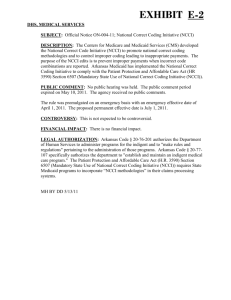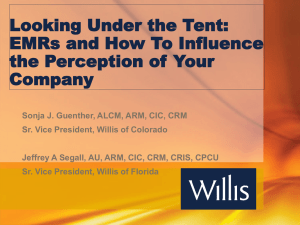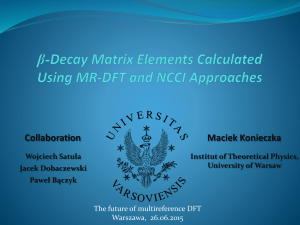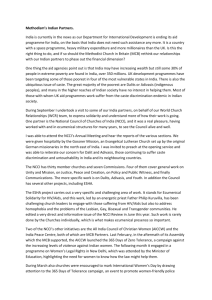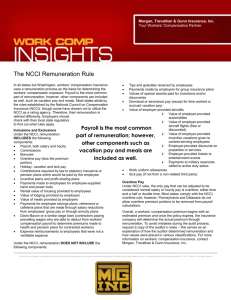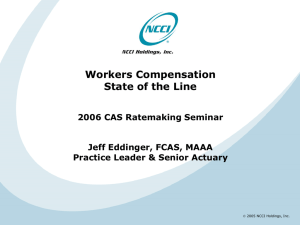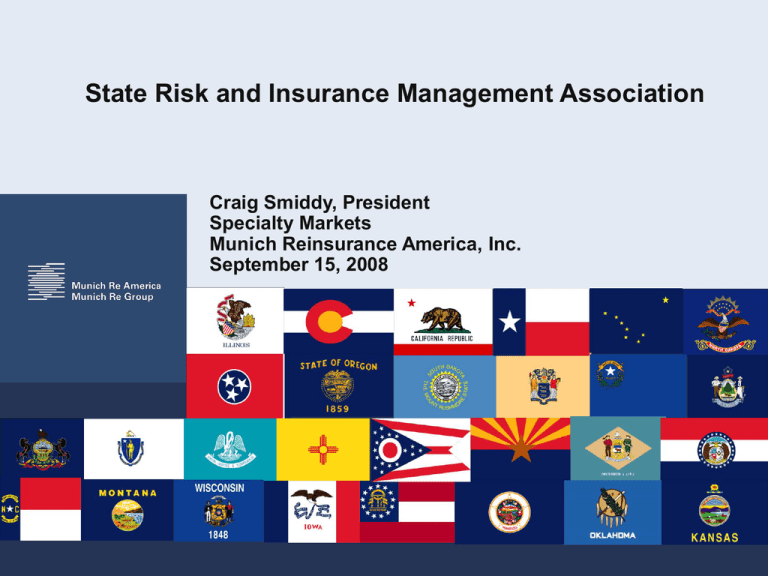
State Risk and Insurance Management Association
Craig Smiddy, President
Specialty Markets
Munich Reinsurance America, Inc.
September 15, 2008
State and Public Entity Emerging Exposures and Trends
Wrongful Convictions
Police Excessive Force
Tasers, Pepper Spray, Rubber Bullets
Failure to Educate
Police Pursuit
Employment Practice Liability
Dangerous Conditions on Public Property
Land Use
2
Climate Change
Arid regions will become drier.
Wet regions will become wetter.
Extremes of weather will become more common.
Increases in frequency and/or severity will impact future losses:
Wild Fires
Winter Storms
Flooding
3
Land Use –
Compounding Flooding from Climate Change
Reduction of natural drainage patterns
Development of flood plains
Levee failures
4
Climate Change Litigation
Lawsuits against greenhouse gas emitters for property damage allegedly
caused by global warming.
Major emitters of greenhouse gases can no longer argue they were
unaware of risks.
“Business as usual” may be viewed as negligent in the future.
Source: Risk and Insurance, 09/15/07; Reuters, 02/02/07
5
Legal, Legislative & Regulatory Issues
Florida: Size of Florida’s Hurricane Catastrophe Fund may be scaled back due to belief there is too much risk carried by the
state, but no bills pending at this time.
FEMA: It has been reported that, due to policy adjustment at FEMA, public entities susceptible to property damage in
successive disasters of the same type no longer can count on federal aid to routinely cover their uninsured losses. Under
FEMA's modified approach, public entities without adequate insurance after sustaining losses in a national disaster face
losing federal aid altogether in some cases and receiving assistance that would cover only a fraction of their uninsured
damage in other instances.
National CAT Plan: Currently no catalyst for Congressional reform, but that may change if major hurricane hits. Both parties
made federal natural disaster policy a part of national platforms for upcoming election. If a major storm hits during
election campaign, a national cat plan may quickly become a central issue
Flood Reform: Bill to restore financial solvency of NFIP through 2013 passed by House and Senate. House version includes
coverage for wind damage; Senate version does not. It is expected that a conference committee will resolve differences
between the two bills.
Proactive Federal Legislation Focused on Consumers Needs:
HR 6424 (Companion to S 2328) would give federal funds to states so they can provide low-cost loans to property
owners to undertake construction projects designed to better protect their property from natural disasters.
S. 2327 – The Homeowners Insurance Assistance Act of 2007 would provide a one-year tax credit to help
homeowners in coastal areas offset the cost of rising homeowners’ insurance premiums.
Sources: Reinsurance Association of America; www.govtrack.us; Business Insurance, Aug 4, 2008
7
State Tort Claims Acts Under Pressure
Ebb and flow over the years has lead to many different rules – state,
federal, statutory, common law, constitutional.
Liability through waiver of immunity by act of legislature or judges.
Liability through contracts.
Movements to Increase Tort Caps.
Immunity not always available under Act - ownership or use of motor
vehicle, construction and operation of buildings, sudden and
accidental discharge of pollutants.
Definition of governmental entity – private corporate vs. public
Distinction between “governmental” and “proprietary” functions
Function and character of the act rather than the actor
8
State Tort Claims Acts Under Pressure
(Continued)
Governmental/setting policy = not normally done by private
corporations, e.g. parks, public safety law enforcement, jails, garbage
services, setting policy, judicial function
Proprietary/discretionary/ministerial = having a commercial purpose,
for private advantage or benefit for local citizens.
General rule for public officials and judiciary – immune while
functioning for the state, but can be liable if acting outside of scope
and/or with gross negligence or wanton disregard.
Purchase of insurance in some states waives immunity to extent of
insurance.
9
Workplace Injury Incidence Rates –
Will the decline continue?
3750
Claims per 100,000 Workers
(NCCI)
Incidence Rates per 100 FTE Workers
(BLS)
15
10
2500
5
1250
2007p
2006
2005
2004
2003
2002
2001
2000
1999
1998
1997
1996
1995
1994
1993
1992
1991
1990
1989
1988
1987
1986
1985
1984
1983
1982
1981
1980
0
Recessions
Manufacturing Industry Injuries and Illnesses per 100 Full-Time Workers
Private Industry Injuries and Illnesses per 100 Full-Time Workers
NCCI Lost-Time Claims per 100,000 Workers
0
Source: US Department of Labor, Bureau of Labor Statistics (BLS), National Bureau of Economic Research; NCCI Frequency and
Severity Analysis, Insurance Information Institute
10
Workers Compensation- Medical Claims CostsContinue to Climb
Medical
Claim Cost ($000s)
$25.4
$24.0
Annual Change 1991–1993: +1.9%
$22.1
Annual Change 1994–2001: +8.9%
$20.2
Annual Change 2002-2006:
+7.8%
$19.0
$20
$17.7
$16.5
$14.5
$15
$13.5
$12.2
$11.3
$10.3
$9.5
$10 $8.4 $8.5 $8.3 $9.1
Cumulative Change = +200%
$25
(1993-2007p)
$5
91
92
93
94
95
96
97
98
99
00
01
Accident Year
2007p: Preliminary based on data valued as of 12/31/2007
1991-2006: Based on data through 12/31/2006, developed to ultimate
Based on the states where NCCI provides ratemaking services; Excludes the effects of deductible policies
Source: Insurance Information Institute
02
03
04
05
06 07p
11
Workers Compensation- Indemnity Claim CostsGrowth Is More Moderate
Indemnity
Claim Cost ($ 000s)
21
19
17
Annual Change 1991–1993:
Annual Change 1994–2001:
Annual Change 2002–2006:
+4.0%
+5.0%
+2.7%
+4.5%+1.1%
+8.9%+2.3%
-1.7%
+7.3%
+3.1%
+10.1%
15
2004
2005
$19.8
2003
$19.1
2002
$18.2
2001
$17.7
1996
$17.5
1995
$16.8
$10.6
1994
$16.4
$10.0
1993
$15.0
$9.8
1992
$12.4
$9.4
1991
$11.4
$9.6
7
$9.9
9
$13.7
+10.1%
+9.0%
13
+7.7%
+5.9%
11 +1.0%
+1.7%
+4.9%
-3.1%-2.8%
5
1997
1998
1999
2000
2006 2007p
Accident Year
2007p: Preliminary based on data valued as of 12/31/2007
1991–2006: Based on data through 12/31/2006, developed to ultimate
Based on the states where NCCI provides ratemaking services
Excludes the effects of deductible policies Source: Insurance Information Institute
12
Workers Compensation - Calendar Year
Combined Ratios – On the Rise Again?
Percent
140
Loss
117
120
LAE
Underwriting Expense
123 121
1.9% Due to
September 11
Dividends
122
115 118
109
102
107
97
111 110
107
100 101
103
93
100
99
80
60
40
20
0
1990 1991 1992 1993 1994 1995 1996 1997 1998 1999 2000 2001 2002 2003 2004 2005 2006 2007p
p = Preliminary
Calendar Year
Source: 1990–2006, Best's Aggregates & Averages; 2007p, NCCI; Insurance Information Institute
13
Workers CompensationResidual Markets Depopulating
Premium as a Percentage of Direct Written Premium
Percent
30
29 28
26
24
25
24
22
18 17
20
17
16
15
13 13
11
10
9
11
8
4
5
12
10
8
5
3
3
0
p
07
20
06
20
05
20
04
20
03
20
02
20
01
20
00
20
99
19
98
19
97
19
96
19
95
19
94
19
93
19
92
19
91
19
90
19
89
19
88
19
87
19
86
19
85
19
p Preliminary
•NCCI Plan states plus DE, IN, MA, MI, NJ, NC
Source: NCCI, Insurance Information Institute
Calendar Year
14
Workers Compensation – Emerging Trends
Obesity
Aging Workforce
Returning Injured War Veterans to the Workforce
Non-English Speaking Workers
Increases in the Rate of Inflation
Source: Insurance Information Institute
15
Thank you for your attention. Questions?
Craig Smiddy, President
Specialty Markets
Munich Reinsurance America, Inc.
September 15, 2008
© Copyright 2008 Munich Reinsurance America, Inc. All rights reserved. The Munich Re America name is a
mark owned by Munich Reinsurance America, Inc.
The material in this presentation is provided for your information only, and is not permitted to be further
distributed without the express written permission of Munich Reinsurance America. This material is not
intended to be legal, underwriting, financial, or any other type of professional advice.

